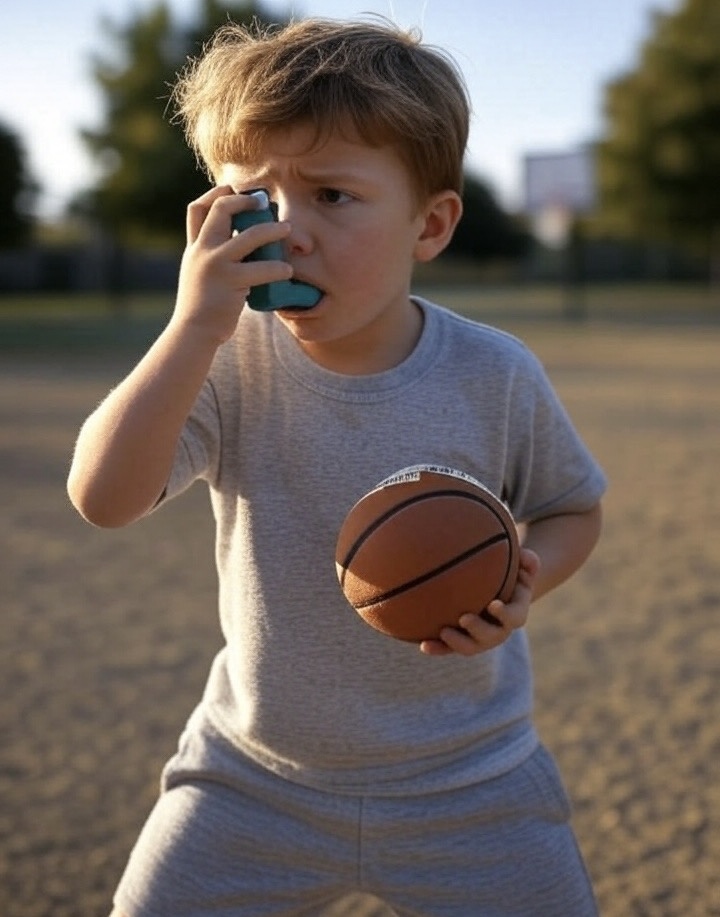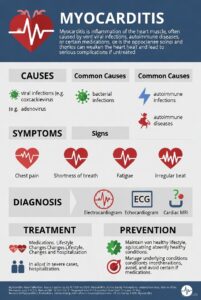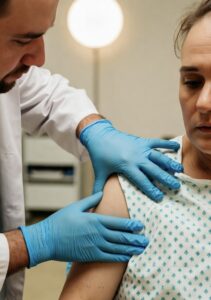Children with asthma, similar to most children, enjoy being physically active, participating in school physical education activities, sports, or even just after-school and weekend games. Some of these activities provoke respiratory symptoms in the asthmatic child, a complaint not infrequently heard in the offices of primary care physicians and paediatricians. Occasionally, this is the initial presenting symptom in a child not previously known to have asthma. When physical activity causes symptoms in an asthmatic child, cough and dyspnea are the most common complaints, with chest tightness being a close second. Wheezing is mentioned less often, even when specific inquiries are made.
Exercise is likely the second most common trigger of asthma (after viral respiratory infections); however, it is often overlooked unless carefully sought. Symptoms may first appear when the child participates in gym activities in school. After establishing that the school-age child participates in gym classes, the best question directed to the child from the physician is, “What happens when you run fast around the gym?”. The parents often express surprise when the child answers, “I cough”. The child may mention shortness of breath, chest tightness or difficulty “breathing air in”, which limits their activity. Tightness in the throat may suggest vocal cord dysfunction (VCD). Parents are typically not aware of the child’s respiratory symptoms in the school gym. Further inquiry may reveal symptoms associated with activities at home or with sports.
For the older child, the association between exercise and respiratory symptoms becomes clearer. The activities that provoke these symptoms are, quite predictably, those causing prolonged, rapid breathing. Typical examples are distance running and soccer. For some children, figure skating, ice hockey, cross-country skiing, paddling, cycling and dancing can be problematic. Activities that rarely cause symptoms include volleyball, downhill skiing, softball, baseball and taekwondo. These activities do not require prolonged, rapid breathing. Be aware that running laps around the field before a ball game or the gym before taekwondo may provoke asthma symptoms. Certain activities have a variable effect, such as basketball – which is usually not a problem for the younger asthmatic child, but which may be troublesome for the older, more competitive player (especially when, as one of the better players, the score is close and the coach leaves them in the game).
Gymnastics can occasionally cause symptoms, but only if the activity requires prolonged, rapid breathing. Swimming has often been recommended for asthmatic children because the activity is conducted in the warm, moist environment of an indoor pool. The author has seen many competitive swimmers with asthma and, although they may have no symptoms with practices, races can be troublesome. In some cases, the symptoms may be more bothersome with a particular stroke (eg, butterfly). The asthmatic child whose symptoms are worse in a particular pool may be reacting to the organic chlorine chemicals (trichloramines) (1).
The hockey player presents a special case. Some experience no symptoms of asthma and enjoy skating in cold, dry air, but others do not. Hockey players typically play in many different arenas, and it may be educational to ask the symptomatic hockey player to name their ‘best’ rink and their ‘worst’ rink. This author has observed that rinks that are colder and have low roofs tend to be worse than those that are warmer and have high roofs. Nitrogen dioxide and particulate matter from fossil-fuelled ice resurfacing machines (ie, Zambonis) may be closer to the ice surface in rinks with low roofs (2,3). It should also be noted that asthmatic goalies do not experience symptoms during the hockey game, but invariably do experience symptoms during practices when skating around the ice causes prolonged, rapid breathing.
Physical examination is rarely helpful when the asymptomatic child is seen in the office or clinic, and spirometry is normal unless the child has mild or moderate persistent asthma. Occasionally, a child with a low normal forced expiratory volume in 1 s will have a significant response to a bronchodilator in the pulmonary function laboratory. Studies involving athletes have shown that the typical symptoms associated with asthma are neither sensitive nor specific for identifying individuals with exercise-induced asthma (EIA) (4). It has been recommended that exercise testing with bike or treadmill, or even a sports-specific exercise challenge that simulates the training and competition environment, be performed (5,6). This may be appropriate in some situations when the facilities are available, but is not very practical in the typical office setting. The controlled laboratory environment may not always reproduce the child’s symptoms and a negative test does not rule out exercise as a trigger of asthma (6). Similarly, methacholine challenge tests may be normal in the child with EIA.
Other causes of exercise-associated symptoms, such as VCD, need to be considered as well as symptoms arising from poor physical fitness, occasionally related to obesity. The clue to VCD is inspiratory stridor from partial vocal cord closure and normal oxygen saturations during exercise and, in the obese child, dyspnea without coughing. The author prefers the term EIA as long as it is understood that exercise is a trigger of pre-existing asthma and not a cause of asthma. The term ‘exercise-induced bronchoconstriction’ is preferred by others, particularly when used to describe individuals not known to have asthma but with bronchoconstriction associated with exercise (7). It has been suggested that repeated environmental exposure, such as cold air in cross-country skiers, nitrogen oxides from ice resurfacing machines and trichloramines in swimming pools, may cause asthma-like symptoms in previously healthy individuals (5).
Several theories have been proposed to explain EIA, which is reported to occur in 80% to 90% of asthmatics (5). Inspired air is normally heated to 37°C and fully saturated with water vapour by the airways. The first theory proposed is that rapid breathing during exercise causes heat and water loss. This is compounded by breathing air that is dry and cold. Airway cooling causes reflex bronchoconstriction and, at the end of exercise, rebound vasodilatation occurs, causing mucosal edema, which leads to airway narrowing. The second theory suggests that hyperventilation causes airway drying, which eventually leads to the release of mediators that cause bronchoconstriction. Others have shown that exercise-induced deep inspirations mechanically stretch the airway smooth muscle bronchodilating the lower airways. Bronchoconstriction occurs following exercise when the airways rewarm, leading to engorgement of the vascular bed. For years, it was taught that the symptoms of EIA occur following exercise. We now know that this is not necessarily the case, particularly in children (8). Children with EIA experience a shorter period of bronchodilatation, and the bronchoconstrictor response starts during exercise. This is consistent with the clinical history when the child reports symptoms commencing during, not following, the activity.
The management of EIA should begin with a brief explanation to the child and parents about the mechanisms causing EIA and that symptoms are invariably associated with any activity that causes prolonged rapid breathing. Having the child list the activities that cause symptoms and those that do not will usually make the point. A cold, dry environment can certainly be a triggering factor, but many asthmatic children experience symptoms in a warm school gymnasium.
For symptoms occurring at school, the parents should meet with the child’s teacher and the gym instructor or coach. Modifications to the activity or sport, if possible, can be helpful when the symptoms are limiting the child’s participation. Avoiding running during warm-ups before ball games, volleyball and taekwondo may be helpful. Shorter distances of track and field, long jump or high jump do not require prolonged rapid breathing and allow the child to participate. The author has seen many discouraged cross-country runners limited solely by their EIA. Becoming a fullback in soccer or engaging in shorter distances in paddling may be helpful. The author is aware of several asthmatic children who excelled as goal-keepers in soccer and could play the entire game without symptoms, something they otherwise would not have been able to do. Predictably, they experience their symptoms during practices when they are required to run laps around the field with the other players. If the child reports that they are goalkeepers in hockey, soccer, lacrosse or field hockey, do not miss the opportunity to ask them why they chose that particular position. The asthmatic child may have already learned that they can more fully participate and experience fewer symptoms. Ice hockey can be a problem. One never tells a competitive forward to become a goalie. The children themselves learn to expect more symptoms when, having contracted a respiratory virus, their weekend game is going to be in their ‘worst’ rink.
Guidelines regarding EIA usually recommend warm-ups before planned exercise to take advantage of the induced refractory period (7). Warm-ups may be beneficial for the elite athlete or those participating in a scheduled track and field event, but are rarely helpful for hockey players or for most school-based gym and sports activities. It is important to ensure, as much as possible, that the child’s asthma control is ideal. Improving a child’s technique with their metered-dose inhaler (puffer) and spacing device occasionally is sufficient. In addition to what the child may be prescribed for day-to-day asthma control, the primary pharmacological treatment for EIA is a short-acting beta-agonist 10 min to 15 min before activities that cause symptoms. In the school setting, this requires the medication to be readily available. A suitable plan needs to be established with school staff because the parent is not going to be present. It is imperative that the child knows how to properly self-administer the medication and that the technique be reviewed in the physician’s office.
Outside the school setting, parents or surrogates can supervise medication use and, importantly, take note of whether the medication is working. It is rare for a couple of puffs of a beta-agonist to completely prevent all symptoms of EIA, but they can help. Success depends on the particular sport, the level of activity and the severity of the child’s asthma. The author allows additional doses of the beta-agonist to be used when the activity is prolonged, eg, hockey and soccer.
Optimizing asthma control is essential. Regular daily use of inhaled corticosteroids may be required for the child with more troublesome asthma, and add-on therapy with a long-acting beta-agonist or leukotriene receptor antagonist may occasionally be necessary. Some guidelines suggest that the presence of EIA reflects asthma that is poorly controlled, and the solution is to increase the inhaled corticosteroids or provide additional therapy (9). The author has seen many children whose overall asthma control is excellent but who experience breakthrough symptoms during sport. In an attempt to bring these symptoms under control, the inhaled corticosteroids have been increased to excessive levels, risking side effects including adrenal suppression. Caution is required. The administration of an inhaled corticosteroid just before the activity is not beneficial and should be discouraged. Children with EIA and allergies may benefit from an allergy consultation and the use of an antihistamine (7). Elite athletes competing at high levels and physicians should be aware of the guidelines provided by the World Anti-Doping Agency (10).
Physical training, exercise and participation in sports should be encouraged in all children including those with asthma. Asthmatic children should not simply be told to limit their physical activities. Such activities will not improve lung function in the asthmatic but can improve physical fitness, allow participation with peers and lead to improved quality of life (11). The asthmatic child and parents will benefit from the advice of a physician knowledgeable about EIA, its presentation and management.
REFERENCES
- 1.Bernard A, Carbonnelle S, de Burbure C, et al. Chlorinated pool attendance, atopy and the risk of asthma during childhood. Environ Health Perspect. 2006;114:1567–73. doi: 10.1289/ehp.8461. [DOI] [PMC free article] [PubMed] [Google Scholar]
- 2.Rundell KW. High levels of airborne ultrafine and fine particulate matter in indoor ice arenas. Inhal Toxicol. 2003;15:237–50. doi: 10.1080/08958370304502. [DOI] [PubMed] [Google Scholar]
- 3.Thunqvist P, Lilja G, Wickman M, et al. Asthma in children exposed to nitrogen dioxide in ice arenas. Eur Respir J. 2002;20:646–50. doi: 10.1183/09031936.02.00266302. [DOI] [PubMed] [Google Scholar]
- 4.Rundell KW, Im J, Mayers LB, et al. Self-reported symptoms and exercise induced asthma in the elite athlete. Med Sci Sports Exerc. 2001;33:208–13. doi: 10.1097/00005768-200102000-00006. [DOI] [PubMed] [Google Scholar]
- 5.Carlsen K-H. The breathless adolescent asthmatic athlete. Eur Respir J. 2011;38:713–20. doi: 10.1183/09031936.00068510. [DOI] [PubMed] [Google Scholar]
- 6.Kansra S, Vyas H. Dyspnoea in the competitive paediatric athlete. J Paediatr Child Health. 2012;22:536–40. [Google Scholar]
- 7.Parsons JP, Hollstrand TS, Mastronarde JG, et al. An official American Thoracic Society clinical practice guideline: Exercise-induced bronchoconstriction. Am J Respir Crit Care Med. 2013;187:1016–27. doi: 10.1164/rccm.201303-0437ST.[DOI] [PubMed] [Google Scholar]
- 8.van Leeuwen JC, Driessen JMM, de Jongh FHC, et al. Monitoring pulmonary function during exercise in children with asthma. Arch Dis Child. 2011;96:664–8. doi: 10.1136/adc.2010.209411. [DOI] [PubMed] [Google Scholar]
- 9.National Asthma Council Australia. Asthma Management Handbook 2006. Melbourne: 2006. [Google Scholar]
- 10.World Anti-Doping Agency. < www.wada-ama.org/> (Accessed October 3, 2014).
- 11.Basaran S, Guler-Uysal F, Ergen N, et al. Effects of physical exercise on quality of life, exercise capacity and pulmonary function in children with asthma. J Rehabil Med. 2006;38:130–5. doi: 10.1080/16501970500476142. [DOI] [PubMed] [Google Scholar]
Original Article – https://pmc.ncbi.nlm.nih.gov/articles/PMC4235445/





